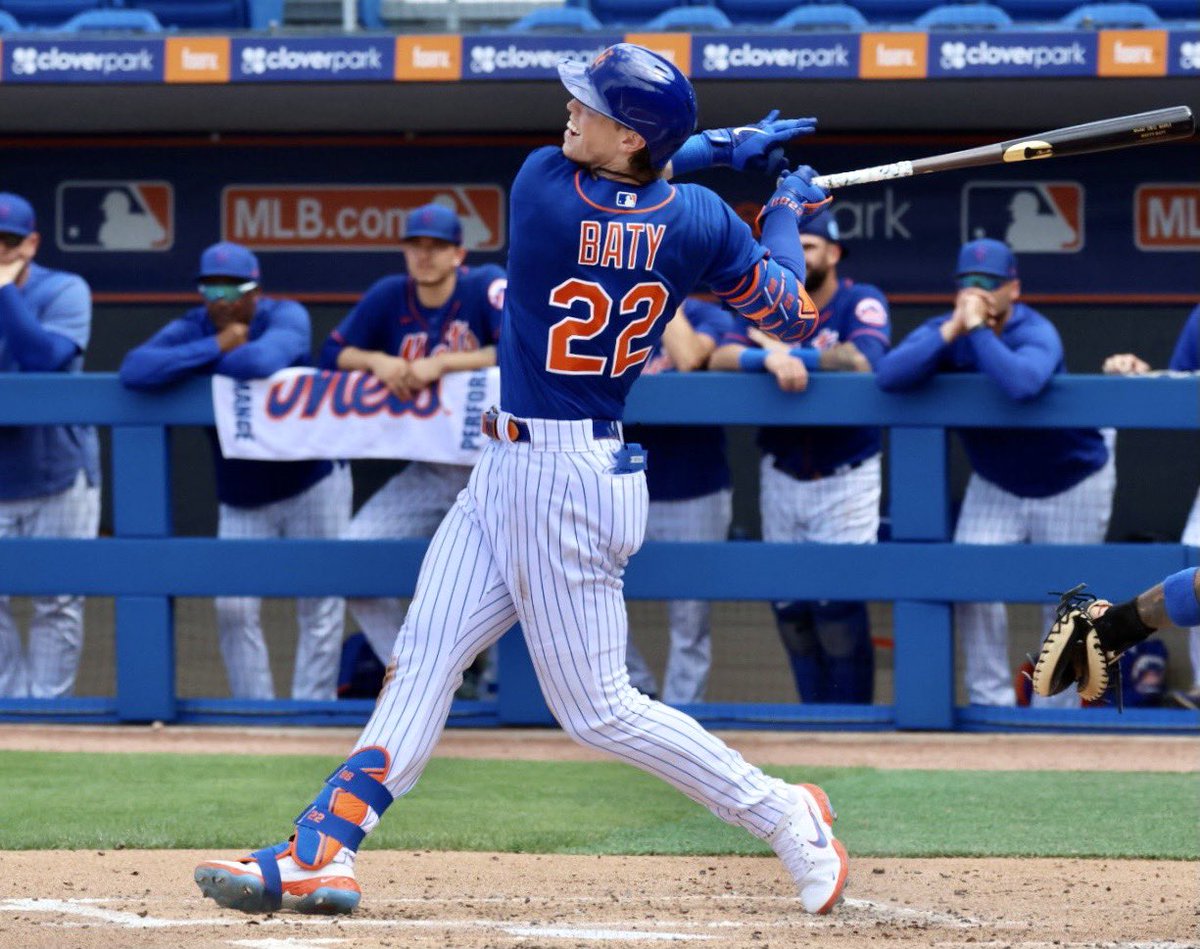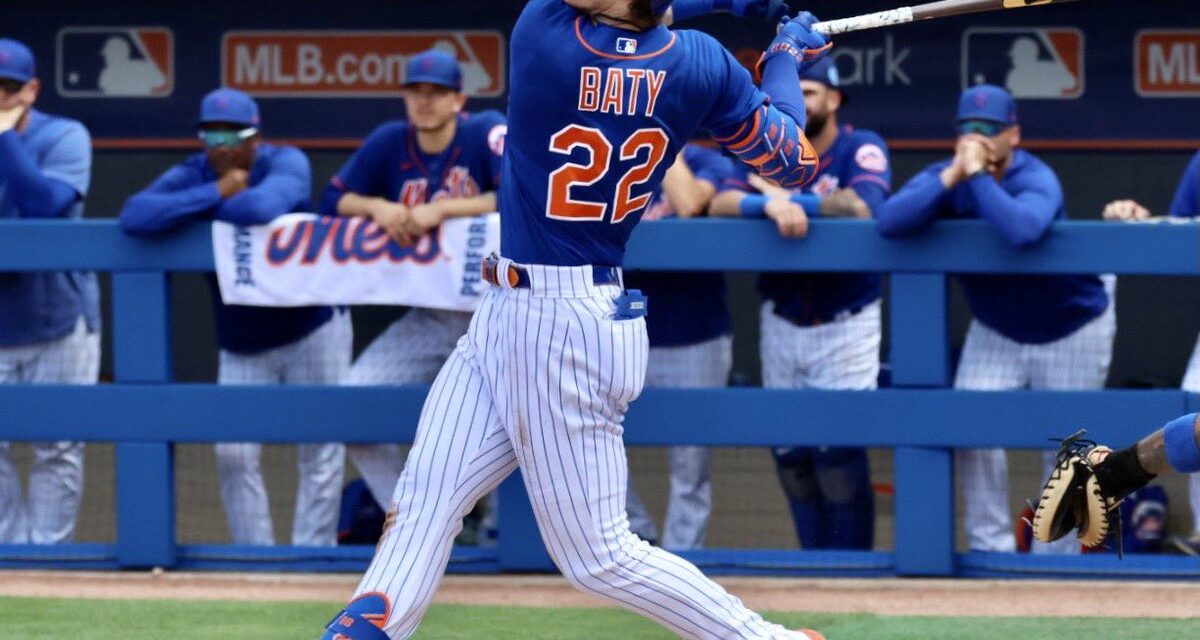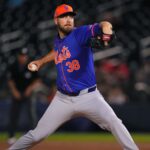
Photo by Ed Delany of Metsmerized
The top Mets event of the young 2023 season is here: Brett Baty is finally joining the major league roster.
Fans have cajoled, begged, and pleaded for the 23-year-old to be called up since the moment it was announced that he was optioned to Triple-A. (I argued that he had earned the right to the starting third baseman role a mere few hours before that decision went public.) After Billy Eppler went to watch Baty play, he apparently came to the same conclusion that the fan base did.
Whenever a top prospect is elevated in New York, expectations will naturally be through the roof. With Baty, they’ll be all the more acute with the way he has been raking at Syracuse to the tune of a 1.386 OPS.
However, it’s important to temper those hopes and dreams with a dose of reality. While Baty could hit the ground running in Los Angeles, it’s more likely that he’ll endure at least some growing pains. His 11-game sample size last season showed both the adjustment and the promise. Francisco Alvarez has shown more of the former thus far as he deals with a lack of playing time and the dual responsibilities of hitting and catching. Baty might not be quite as raw as Alvarez, but he is still a rookie.
What are realistic projections for Baty? What are the signs the Mets would want to see from him to believe that they have their long-term answer at third base?
Exit Velocity and Launch Angle
With Baty, hitting the ball hard is never in question. He knocks the cover off the ball on a regular basis. The sticking point is whether he can elevate.
In Baty’s cameo last season, his average exit velocity was 91.1 mph, per Baseball Savant, which would have ranked in the 86th percentile among batters. However, his average launch angle was just 10 degrees, which would have been in the 26th percentile.
During his strong spring training, in another small sample size, Baty’s average launch angle was up to 15.1 degrees, which would currently rank in the 66th percentile among qualified hitters.
Baty may struggle to elevate the ball in his early days in the majors, and that’s okay. The bigger question is whether he can show improvement in this area as he gains more experience. He has consistently shown that level of improvement in the minors; can he continue it at the next level?
With the way the ball flies off Baty’s bat, if he puts it in the air rather than on the ground, good things will happen.
Batting Eye
In his short 2022 stint, Baty’s chase rate was 30.6%, which would have ranked in the 35th percentile among qualified hitters. That’s a number he’ll likely want to improve in a longer 2023 stretch.
In general, Baty has long been known for his excellent eye, which gives him the potential to pick things up in the majors more quickly. His 67.6% zone swing rate would have been just about dead-average, and his 91.7% meatball swing rate would have been the third-best in baseball. (The latter includes a tiny sample size of just 12 pitches, but it’s instructive that Baty swung at 11 of them.)
In the minors this year, Baty’s 16.7% walk rate (seven walks in 42 plate appearances) exceeds his 2021-22 minor league average of roughly 10-11%. (For reference, Brandon Nimmo’s career walk rate is 13.9%, and Daniel Vogelbach’s is 15.9%.) While Baty’s walk rate in the majors last year was just 4.5%, getting that rate up to roughly league average, which is around the 8.5-9% mark, would be a good sign of his staying power, as would keeping his strikeout rate in the low-20% range.
Seeing Baty pick good pitches to hit would tell the Mets that he’s ready for primetime.
Minimizing Defensive Miscues
It appears that the Mets’ primary worry with Baty defensively was not that he would miss the splash plays at third but that he’d bungle the routine plays. Eppler must have satisfied his concerns on that score for Baty to be in the majors.
Indeed, an abundance of errors at third was a problem for Baty last season, both in the minors and majors. He combined for 17 errors across three levels in roughly 77 games’ worth. Baty does already have two errors in roughly eight games’ worth of fielding this season, but he looks much smoother overall.
As Nimmo has demonstrated, defensive aptitude is not a stagnant skill. The Mets wanted Baty to work on his defense in the minors to avoid making costly plays. As long as he can give them a baseline of competence, he can continue to work on his glove at the big-league level. If he’s booting balls or making routine misplays on a regular basis, though, it will be difficult to keep him on the field.
Few Traditional Metric Goals
Obviously, all Mets fans will want to see Baty win Rookie of the Year and start mashing home runs from the get-go. However, placing expectations on his batting average, home run totals, and other traditional numbers is generally a recipe for disappointment.
Yes, the Braves had Michael Harris last season. Yes, Jordan Walker is going off for the Cardinals in the early going. These youngsters who come up and succeed right away are becoming more and more common across baseball.
However, you also have Anthony Volpe, who’s currently hitting .191. There’s Jarred Kelenic, who endured two miserable seasons of being repeatedly sent down to the minors before he was 23 years old.
Sometimes, a prospect who struggles early will be a bust—and sometimes, they’ll figure it out. A Mets prospect will be in the spotlight just by virtue of playing in New York. Measuring Baty’s performance by improvement rather than homers and RBIs will yield a more complete picture of how the kid is truly doing.
I believe that I myself placed a 15-homer expectation on Baty’s head sometime during the offseason, so I am not immune from the excitement as an analyst. Focusing on the process, though, is what Baty should be doing. The zoomed-out view will benefit him and the team over the course of a long season and beyond.















